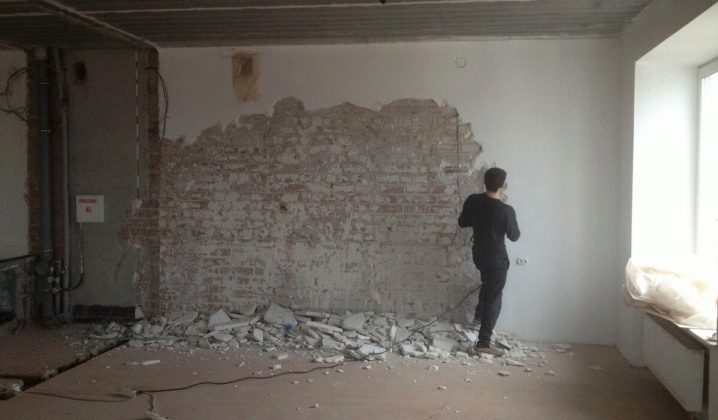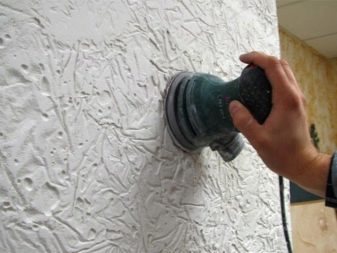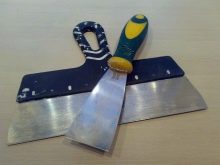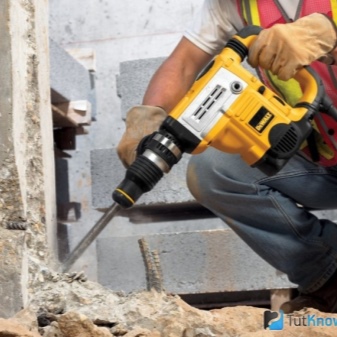Plaster dismantling process

Plaster is a fairly durable finishing material that can last for more than a dozen years, but only if all technological requirements for plastering are met. There are a number of factors that lead to a violation of the layer of this type of finish. In such situations, it needs to be completely replaced.
The process of dismantling plaster, at first glance, does not require special skills. However, in order to remove the putty, you will have to arm yourself with certain knowledge.

Peculiarities
Often in the process of repairing people think about how to remove the old layer of plaster from the walls, and whether it is worth doing it at all. In order to properly carry out the necessary work, you should familiarize yourself with some of the nuances of this process.
Based on the nature of the deformations, all damage to the plaster is conventionally divided into two main types:
- Technological defects are those that appear due to non-compliance with the technology for preparing the batch or if it is incorrectly applied.
- Operational defects arise during the period of operation. The reason is, as a rule, unfavorable conditions, various mechanical influences or a long period of use.


Depending on the situation, the dismantling of damaged plaster can be complete or partial. Complete dismantling is carried out if the finish has become unusable from prolonged use, its appearance has deteriorated, and a layer of plaster has begun to crumble over the entire surface. Partial replacement is made only in some places where the layer has slightly crumbled if the bulk remains intact.
Finding out which areas need replacing is easy enough - the previously plastered surface must be tapped with a hammer handle or other blunt object. In places where a dull sound is clearly audible (there are voids), repairs are needed. Mold or mildew is also an obvious sign of a change in finish.


If the composition of the coating included cement, then over time the surface may become cracked, but this does not mean that a layer replacement is required. If, when tapping, the finish does not begin to crumble and crumble, then there is no need to replace the plaster.
If more than 70% of the surface has peeled off and crumbled, then it is more advisable to completely beat off the layer of the old plaster. The old coating layer must necessarily be stronger and heavier than the new one, otherwise the finish will not be able to securely fix and will disappear over time.

Types of mixtures
Having decided on the need to remove the old finishing layer, the next step is to study what dismantling methods can be used. The latter depend on the type of previously applied mixture. In any case, first remove the weak areas of the plaster over the entire surface using a hand tool. After these manipulations, mechanized methods can be applied.
Gypsum plaster is especially easy to get off. Such a coating is rather loose, not too strong and unstable to moisture. Before removing the plaster finish, it is necessary to wet the walls well (20 minutes before starting work). To make the material soft and friable, it is advisable to add a small amount of acetic acid to the water. The same method is used to dismantle plaster on a clay or lime base.


Decorative plaster from gypsum is removed quite simply, which cannot be said about polymer (acrylic) or silicate compounds. The latter are highly durable, and it can be very problematic to remove them. However, the advantage of such coatings is that they can be left intact, since they are a reliable basis for a new layer, regardless of its composition.

When dismantling decorative or Venetian finishes, the use of a perforator is unacceptable, since this coating has a very thin layer, and if inaccurately applied, the base of the wall can be damaged.
It is undesirable to knock down such plaster, therefore it is better to remove it with an ordinary scraper or clean it off with a grinding and roughening machine.
With the latter tool, the process is much faster., and even removing textured plaster becomes easy and takes a little time. It is enough just to "walk" several times with the sole of the switched on machine on the surface of the wall with a certain pressing force. The disadvantage of this method is only the need to purchase a rather expensive tool.


Removing concrete plaster from walls is not easy. In some cases it is difficult to do this even with a hammer drill, as the coating is thick and durable. In such situations, it is necessary to use a grinder to cut the coating into squares of half a meter in size. After that, the dismantling process becomes easier.


Tools and equipment
Regardless of the method of dismantling, you need to "arm" with a certain set of tools:
- a respirator or face shield to protect the respiratory tract and tight-fitting goggles to protect the eyes;
- construction gloves;
- a wide brush and a container for water or a garden sprayer;
- chisel for ease of use (preferably with an extended handle);
- with an ax, hammer, sledgehammer or pickaxe;
- spatula, scraper, cycles;



- manual metal brush;
- a hammer drill with wide nozzles or a drill with a bump stop;
- grinder with matching discs;
- a machine for cleaning coarsely abrasive plaster;
- scoop, broom or broom, garbage bags.



Removal process
The plaster removal process is, in principle, uncomplicated. Even a person who does not have any experience in construction can do it with his own hands.
In this case, it is better to follow the step-by-step instructions:
- The general requirement for all types of plasters is that you should not start dismantling on a dry surface, the finish should be well wetted. This will help soften the layer and significantly reduce the formation of large amounts of dirt and dust.
- Before cleaning from the old layer, you should carefully analyze the condition of the plaster on the surface. If replacement of the coating is not required, then it is not necessary to remove the entire layer; partial dismantling of weak fragments is sufficient.
- To determine the adhesion of the plaster to the base of the wall or ceiling, tap the surface with a hammer or some other non-sharp metal object. In places with good grip, the sound of impacts will be richer.
- The first step is to break the integrity of the existing coating. This is done on weak areas of the surface, which are removed in small parts. The cleaned fragments allow you to reach the end of the layer.
- Under this layer you need to drive a cycle, steel trowel or scraper and try to remove the coating. Every movement of the plaster under the action of the tool is a sign of poor adhesion to the substrate. Such fragments require mandatory deletion.


- If the finish is holding tight enough and cannot be dismantled, you can use a chisel or chisel and continue beating, lightly tapping the tools with a hammer. It is necessary to hold the tool at an acute angle, this will protect the base of the wall from destruction.
- Stronger compounds that cannot be knocked down with a hammer require the use of a hammer drill or hammer drill. Be prepared for noise and a lot of dust. For concrete surfaces, a grinder should be used first.
- A sander is used to remove small pieces of mortar.
- If there is a brick wall under the plaster, then after removing the coating, it is necessary to knock off the remnants of the finish from the brick and "walk" along the seams with a chisel.


Tips & Tricks
Having familiarized yourself with the stages of plaster removal, you can understand how important, but at the same time, unpleasant this process is.
Builders who are faced with such situations on a daily basis give beginners some useful tips:
- Getting started, you should first determine the location of the wiring and, if necessary, turn off the power supply. Prepare in advance all the tools and materials, as well as the means necessary for personal safety.
- Work with a puncher should be careful not to damage the base of the wall. It is better to remove the plaster layer a little longer than to repair the damaged base again.
- A sander is used on a small layer of coating. If the layer exceeds 3 mm, a vibration sander is used. Its distinctive feature is a different principle of movement of the working element.
- If the old finish layer partially remains on the surface, then the next layer must necessarily be slightly weaker. For example, any composition can be applied to a cement-sand or polymer coating. Gypsum or clay mortar will fit well on the lime layer. Gypsum is not able to withstand the cement layer, as it is heavier. And nothing can be applied on top of the clay plaster, this composition can only withstand its own kind. But the clay-sand mortar will stick to any surface.


- If the layer of plaster is on drywall or on top of shingles, then dismantling should be done carefully, avoiding strong impacts. It is better to remove the coating by hand with a spatula or scraper.
- When applying a new layer of coating, experts advise using a more expensive composition. The main thickness of the previous layer can be “picked up” with the same composition, and applied on top with a more expensive thin layer.
- In the process of dismantling, the problem of disposal of the removed plaster arises. In multi-storey buildings, it is necessary to immediately organize the process of removing construction waste, since there is usually nowhere to store it. In private buildings, construction waste must be placed under a canopy before it can be removed (hide from atmospheric precipitation), because during the rain, waste can increase in weight, which will complicate the loading of waste.
It should be understood that the weight of the plaster in one square. meter with a coating thickness of about 2 cm is about 20-30 kg, depending on the composition of the finish.


- In the process of dismantling, do not forget about moistening the surface to be treated. These manipulations will not only help to loosen the old layer, but will allow you to work in the cleanest possible conditions, without the formation of dust.
- It is better to scrape off plaster from the ceiling with a cycle or a long-handled spatula. With these devices, you can remove the coating with both hands.
See below for possible errors when dismantling the plaster.













The comment was sent successfully.